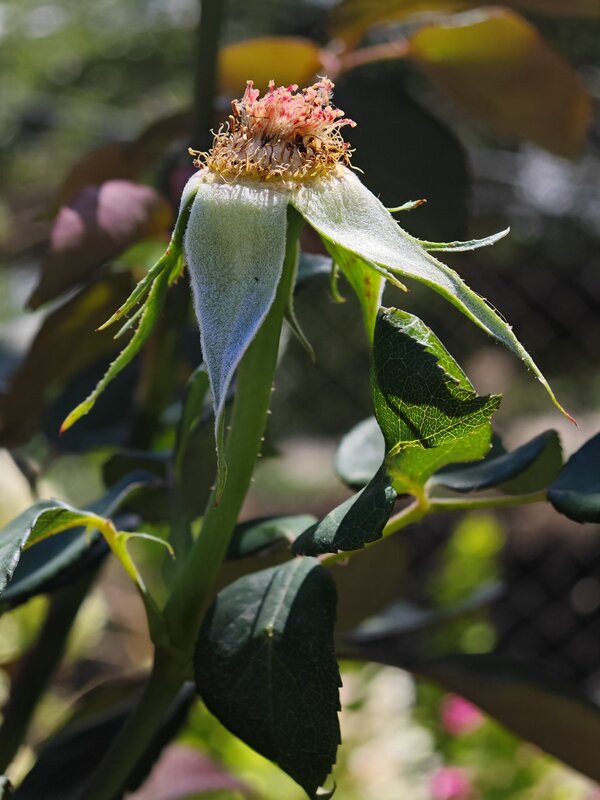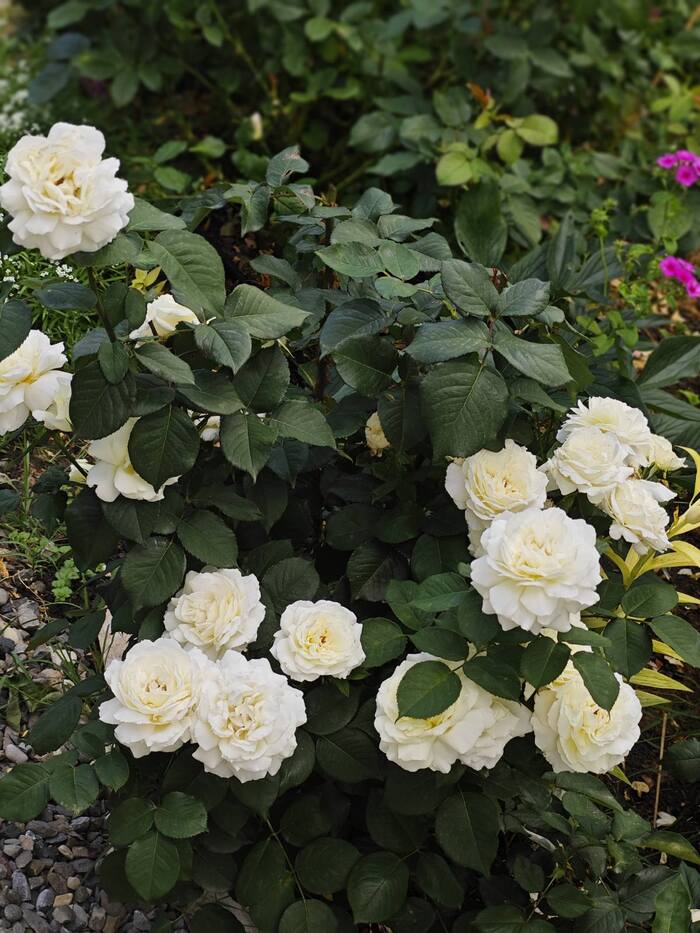As the days grow shorter and the first signs of autumn emerge, rose gardeners enter a vital care and maintenance phase. August and September are pivotal months for ensuring your roses survive the winter and thrive in the coming spring. Let’s delve into the essential rose treatments that will set your garden up for success.
The End of Summer: A Time for Preparation
The summer sun was intense, and your roses have likely put on a beautiful show. However, the end of summer is not just a time for admiring blooms but also for reflection. Take a moment to assess your rose garden. Have particular roses struggled more than others? Are there areas with signs of disease or pest damage? This reflection will guide your treatments for the months ahead.

rose Johann Wolfgang von Goethe
Fertilizing: A Gentle Hand
As we move into August, it’s time to adjust your fertilizing routine. Your roses need nutrients but in a different quantity than earlier in the growing season. Over-fertilizing can encourage new growth that will only have time to harden off after winter.
Action Steps:
Use a Balanced Fertilizer: Apply a balanced fertilizer one last time in early August.
Stop Nitrogen-Rich Fertilizers: Cease the use of high-nitrogen fertilizers after mid-August to avoid stimulating new growth.
Feed your roses with a phosphorus-potassium fertilizer, preferably with microelements. Sprinkle a tablespoon of fertilizer around the base of the plant, loosen the soil to incorporate the granules, and water if necessary.
You can read more about feeding roses in August in this article. – click here
Pruning: Shaping for the Future
By August, you might notice spent blooms and faded petals. This is where deadheading comes into play. Removing old flowers encourages your roses to conserve energy and prepare for winter.
Action Steps:
Snip Away Spent Blooms: Use clean, sharp pruners to cut off dead flowers just above the first set of healthy leaves.
Clean Up Debris: To prevent disease, ensure the area around your roses is free from fallen petals and leaves.
Preparing for Dormancy
In September, it’s time to think about the dormancy period. This involves careful Pruning to ensure your roses enter winter in the best shape possible.
Action Steps:
Light Pruning Only: Avoid heavy Pruning. Instead, focus on removing dead, damaged, or diseased canes.
Reduce Height: Trim the canes to a manageable height to prevent wind damage during winter storms.

Avoiding New Growth in Late Summer
From late August, it is essential to prevent your roses from spending energy on new buds and seed maturation. This ensures the plants go into winter with woody shoots and accumulated strength. While some recommend pruning 10-15 cm, Pruning or even simple pinching of the tips can provoke the growth of side shoots (with new buds, if the weather allows). Remove the petals and seeds from faded buds without cutting the rose branches to avoid this. Perform the Pruning in the spring.
Protecting Against Pests and Diseases
Monitoring for Problems
Even as the season winds down, pests and diseases can still pose a threat. Look for common issues like black spots, powdery mildew, and aphids.
Action Steps:
Inspect Regularly: Check your roses weekly for signs of pests or disease.
Use Organic Sprays: Treat minor infestations like neem oil or insecticidal soap with organic sprays.
Boosting Immunity
Strengthening your roses’ natural defenses can go a long way in preventing problems during the colder months.
Action Steps:
Apply a Fungicide: In early September, consider applying a fungicide to prevent fungal diseases.
Water Wisely: Water at the base of the plant in the morning to reduce humidity around the foliage.

Get Your Free Lunar Gardener's Calendar 2024!
Join the Lunar Gardening Revolution! Subscribe now to receive our exclusive Free Lunar Gardener’s Calendar for 2024. Harness the power of the moon to optimize your planting, nurturing, and harvesting.
Pest Treatment in August
Whitefly
Simultaneously, carry out pest prevention. The most harmful pest for roses during this period is the Whitefly, which can strip roses of their leaves, negatively affecting their health and ability to overwinter. A contact-systemic action product is suitable for Whitefly. Treatments for diseases and pests can be combined.
Aphids
Aphids are tiny, sap-sucking insects that can cause significant damage to roses if left unchecked. They typically cluster on new growth, sucking the plant’s sap and excreting honeydew, which can lead to sooty mold.
- Action Steps:
- Spray with Insecticidal Soap: Use insecticidal soap or neem oil to spray affected areas, ensuring thorough coverage.
- Introduce Beneficial Insects: Release ladybugs or lacewings into your garden as natural predators of aphids.
Spider Mites
Spider mites thrive in hot, dry conditions and can cause leaves to become speckled and discolored. Severe infestations may lead to leaf drop.
- Action Steps:
- Hose Down Plants: Spray the undersides of leaves with a strong jet of water to dislodge mites.
- Apply Miticides: Use miticides specifically designed to target spider mites.
Japanese Beetles
Japanese beetles are notorious for their voracious appetite. They chew on leaves and flowers, which can leave your roses looking tattered.
- Action Steps:
- Hand-Pick Beetles: Remove beetles by hand in the early morning when they are less active and drop them into a bucket of soapy water.
- Use Traps Sparingly: Place traps away from rose bushes to lure beetles away from your plants.

Rosoman Janon rose
Preparing the Soil: The Foundation of Success
Mulching is vital in protecting your roses from the harsh winter weather. It helps retain moisture, regulate soil temperature, and prevent weed growth.
Action Steps:
Spread Organic Mulch: In September, lay down a 2-3 inch layer of organic Mulch around the base of your roses.
Keep Mulch Away from Stems: Ensure the Mulch does not touch the stems directly to prevent rot.
Feeding the Soil
Healthy soil is the cornerstone of a thriving rose garden. Preparing your soil in late summer and early fall sets the stage for robust growth in the spring.
Action Steps:
Add Compost: Work compost into the top layer of soil to enrich it with nutrients.
Check pH Levels: Check the soil pH and adjust as needed to keep it at a slightly acidic level of approximately 6.5.
Deep Watering: Water thoroughly but reduce the frequency, letting the top inch of soil dry out between watering sessions.
The Promise of Spring
The care you invest in your roses during August and September is a promise to the future. Each treatment, from gentle Pruning to thoughtful fertilizing, ensures your roses are ready to face winter’s challenges and emerge more robust and beautiful. With this comprehensive checklist, you can confidently guide your roses through this crucial transition, knowing that a glorious spring display awaits.
Embrace the process, savor the journey, and look forward to the rewards of your diligent care. Happy gardening!

The Organic Rose Revolution: Grow Stunning Blooms, Naturally
- Unlock the secrets of nurturing your roses organically with our guidance on soil health, natural fertilizers, and sustainable pest control methods. Your garden will thrive with eco-friendly care that respects nature’s balance.
- Empower yourself with the knowledge to craft natural remedies for common rose ailments.
- Banish pests from your garden precisely using proven strategies that safeguard your roses without harsh chemicals. Keep aphids, mites, and other invaders at bay while preserving your garden’s natural harmony.
- Explore a world of breathtaking rose varieties carefully curated to captivate your senses and elevate your garden to new heights of beauty.

